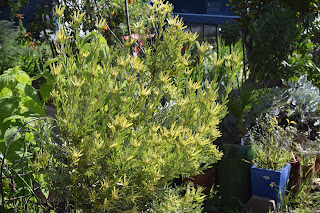Well, spring is just around the corner, especially here in the Bay Area. To our gardens we go!! And for those of us lucky enough to have had the time over the last month or two to get such prep things such as weeding, pruning and mulching done, we greet the coming spring ready to already enjoy its bounty. As many of you know, I have a four season garden. Here are some late winter photos of my garden, with much already in bloom!
Plectranthus 'Troy's Gold'. I love recommending plectranthus species to the customers at our Grand Lake Ace nursery. Hardworking, nearly indestructible and greatly varied in leaf form. This is one of several ground cover types.
One of the more curious pelargoniums out there is this shade-loving Pelargonium 'Caroline's Citrine.' It's all about the leaf color in this vigorous and easy to grow Pel.
What is winter without one or more Cyclamen? This lovely 'flame' cyclamen has red-tipped white flowers and returns from dormancy each fall.
Tho the lower light doesn't do justice to the bright chartreuse leaf color on this Physocarpus 'Gold Nugget', I took the photo anyway.
I'm a camellia lover and here is one of my favorites - C. 'Anticipation Variegated'. Each flower displays a slightly different pattern of pink and white and then you have the ruffled petals. Fabulous.
Those who've followed this blog and seen photos of my garden know I have a large collection of bromeliads. That's especially true for Neoregelias. Here's one that has done especially well. And to set the record straight, a great many bromeliads actually like a good amount of sun. As long as you don't let them dry out.
One of my other passions is flowering bulbs from South Africa. Here's a Lachenalia aloides var. quadricolor. Each flower combines yellow, red, green and a touch of purple. Lovely!
Here are two more mature bromeliads, enjoying the sun and adding pizzazz to our walkway.
Rhodocoma capensis. One of the restios hailing from the Cape region of South Africa, this lovely guy actually produces tiny pink flowers at the tips of its seedheads.
While many consider Chasmanthe bicolor to be an invasive plant - it is vigorous no question - I've planted it in a 'problem spot' in my garden and it has prospered.
Switching continents to Australia, here is a photo of my totally charming Melaleuca incana. Commonly called Gray Honey-Myrtle, this Western Australia native does quite well in our climate. And to my delight, a variety of local bees seem to love the fuzzy nectar-rich flowers.
It took two years to flower but now my Leucadendron 'More Silver' had a banner year in producing its telltale yellow bracts. And the shrub itself is prospering.
I always look forward to this fantastic Aloe striata blooming each year. Fantastic bluish-gray foliage too. And of course, hummers love the flowers.
Any guesses as to which flower this is? Don't feel bad if you didn't realize that it's a lily. Lilium 'Apricot Fudge' is one of the more unusual lilies to be found in the nursery trade. It's always the first to bloom, a good month ahead of the many other variety of lilies in my garden.
Grevillea 'Superb'. One of our best selling nursery Grevilleas, one of the principal reasons is th large and colorful panicles of flowers it produces in great number each spring.
Not an artistic photo to be sure but you know how daffodil flowers are - they all nod. I love the simplicity of this one.
It may take you a second to pick them out but this Grevillea 'Molongo' is loaded with tons of tiny, creamy orange flowers. And I swear, they all pop open in like a two week period.
The same is true for my Dodonea sinuolata. The flowers cum seedpods are very small but appear in great numbers in late winter. One of my favorite plants and one whose ID often stumps even veteran gardeners.
This is a bit of an odd juxtaposition but those are Magnolia 'Butterflies' flowers seeming to be right in front of a window. It's just a depth of field illusion.
Those delicate star-shaped flowers are Ipheions. This bulb returns faithfully each year and gradually colonizes an area.
The orange flowers here belong to a wallflower plant (Erysimum) while the creamy white flowers are species Freesias.
Here is a bigger patch of those species Freesias. They started out as colored hybrids but at some point reverted back to the original species stock.
Here's the first Harlequin flower (Sparaxis) of the year. It has since been joined by two other colors - a bright pink and a pale orange. This bulb also does a great job of naturalizing in a sunny bed.
And lastly, here's a photo of my long blooming Salvia aurea. There aren't many ginger-brown flowers around but this is one of the loveliest.

























No comments:
Post a Comment